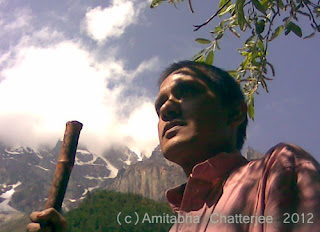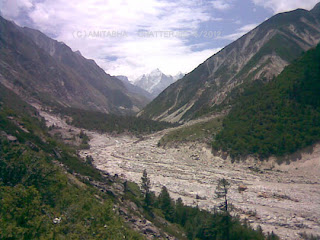Sri-
======== Ramswaroop Brahmachari ========
of Malgalbasa, Gangotri
On 26/6/2012, I reached Haridwar a little before dawn. I took a few dips in the Holy Ganga river near Har-ki-Pauri ghat, it was very cold but refreshing. It took away my fatigue from the train journey.
 |
| Haridwar Har-ki-Pauri Ghat, July 2012 |
Next I boarded on a bus going to Gangotri. This bus stopped on two places (Guptakashi & Chamba) for refreshments and answering natural calls. Thats where I met Mr. Santosh, a guide for high altitude trekking. He joined us on the bus from Guptakashi
.
Santosh told me about his expeditions, experiences and the rescue missions he has taken part in. I asked him, how much it would cost, for a group of 7 people, to go on a high altitude trekking journey, from Gangotri to Badrinath. He said they must also include 3-4 porters, to carry the luggage & supplies, tents, food, etc.; himself, as the guide, and a Cook who will go ahead on the camping spots, cook dishes and serve hot food when the party reaches there. Each of them have their own wage rates, like, Guide = 1000-1200/day, Porter 500/day, Cook 500-700/day (they can cook anything you can think of, even rasgullas!). One must rent the tents and pay for the food of ---> the tourists + the crew (porter, cook, guide).
 |
| Ganga, downward journey |
A journey like this will last 12-14 days upto Badrinath, via Mana, through the icy regions of the Himalayas. They will pass through hail & snowfall, avalanche, ravines and rocks, forests and icy lakes. This kind of a trek will cost Rs. 1 lakh (100,000/=). Whew! I said, Okay, I will contact you, when I have that kind of money to spend, and such a group of brave young men. Actually, the cost is not high, if you consider the conditions of the terrain, the risks involved and the number of people in it. Santosh gave me his contact number. It's 07895863756.
I asked him if he knew any mahatma, or, genuine Sadhu-Baba in the region spanning from Gangotri to Tapovan. after thinking deeply, he replied that nowadays, it is very hard to come across highly realized sadhus (uccha koti ke mahatma); but in his opinion, the mahatma at mangalbasa is quite good. he remains immersed in his sadhana and is not interested in matters of the outer world, or, publicity. This baba is without greed. I thanked Santosh for his pointers on local sadhus and our discussions turned to other subjects.
As soon we reached Gangotri at 7:30 pm, in the evening, I remembered the advice from Santosh and hurried to the Permit Office near the bus stand. Only a small part of the office was still open and I was the last customer. They asked for my identity card (PAN, Voter ID, Passport), which I was luckily carrying. They made me fill up a form and issued a white paper with my details on it.
The next morning, I started my journey at 6:30 am. I purchased a strong stick (5.5 ft) for 40 rupees. This stick was my trusty companion, all over the mountainous terrain. It didn't have the iron cone fitted under it. This iron usually falls off after some time. I found numerous flattened iron pieces all over the path, up-to Gaumukh.
Also, I never carelessly dropped plastic carry-bags/ biscuit wraps on the Gangotri national park. I carried them with me and disposed of them in waste-bins, placed on the roadside. But sadly I witnessed many stupid people polluting the Ganges with plastic wastes. Much awareness is necessary for these people to wake up!
As I passed the check-post near Phalahari Baba's Ashram, the guards stopped me. I had to produce the white permit and pay a sum of 150/= rupees (600 for foreigners). The officer kept the white paper and issued a red counterpart for me. They also provided me with drinking water. On 2003, when I visited Gaumukh, it was for free; I didn't require any permit. I guess they need the money to maintain the afforestation programs, keep the place clean, constantly repair the road for the pilgrims in spite of the frequent landslides.
A few miles after the check-post leads to Mangalbasa, a which used to be a Choti, or, Parhao, or, resting place for tired pilgrims in the olden days. Now, it's abandoned as a Choti, nobody stops there. Luckily enough, I found a few local people sitting there. I asked them, whether there is a Mahatma / Baba living around here. They gave me directions to get off the road and descend along the forested slope towards the Ganges river flowing a few hundred feet below.
I followed their instructions and soon came upon a cave/ dwelling made from boulders and huge rocks. A blanket served as a door at the entrance. I called out several times to draw the attention of the mahatma inside, like, "Vam Bhole, Jai Shiv Shankar, Hari Om, Jai Guru!" But nobody answered back. After trying many times, I went back up towards the road to Bhojbasa. I met the mountain people and told them what I saw. I didn't want to enter the cave without the Baba's permission, for that would be a rude intrusion.
While I was away, a sadhu has joined the group. He had a red shirt on; carried a stick and a steel water-pot. His head was shaved. He volunteered to take me to the Baba below, as he was impressed by 'my eagerness to meet the Mahatma'. I came to learn from him, that the name of the sadhu in question is,
Ramswarup Baba. He was staying in Mangalbasa for 2 years now. On the way, this guide-baba picked some herbs and allowed me to smell them. He said, "These medicinal herbs make good tea and keep the body warm in this cold climate." Later on, while in Gaumukh, I managed to remain alive and fight against cold and hunger by ingesting these herbs along with Ganges water.
Anyway, this guide-sadhu entered the cave and told me to come in. I noticed that there was an inner chamber with door. He pushed the door open and told the Baba, that "A nice guy has come to see you." And then I was invited inside. Once inside, I could hear no outside noise any longer. It was sort of sound-proof! Also, it was quite dark in there. Ramswarup-ji was wearing grey wooly-cotton sweat-shirt and pajamas. His hair was very short and it seemed like he shaved every few days. Its the same about his beard.
 |
| Inside the cave |
The Sadhu-Baba didn't waste any time in meaningless small-talk. He started talking about in-depth spirituality right away. He was not offended when I contradicted with him over several opinions. He is very soft spoken and kind. He wanted to offer me milk-tea, which I politely denied and finally settled for some black herbal tea and biscuits. This was first offered to the image of Lord Vishnu & Laxmi and then served. I took a picture with his permission.
When I showed him the image of my Guru, he respectfully called my master a "Mahapurush", (a very advanced soul) and touched it with his head in prostration. All his behavior exuded some mark of spiritual ascent and lack of vanity. I have seen many sadhus in my life. Usually they don't touch strangers. This Baba offered me a seat on his own Asan (Prayer mat), which I denied, of course, and took my rightful pace on the floor (on a blanket).
I was quite impressed by this quiet and calm Sadhu. I offered him some money, but he politely refused to accept it again and again. Ultimately I left it in front of him and tried my best to persuade him. "You can feed devotees and guests with the money, for food is so scarce in this place!"
While departing, I expressed my desire to visit him on my return journey. He told me that he will be in Gaumukh on the lunar day of Ekadasi. He came out with me up-to the entrance of his cave dwelling. I requested to take his photo on my mobile in the clear daylight.
 |
| In front of his cave dwelling |
On the day of my return from Bhojbasa to Gangotri, as I arrived at Mangalbasa, I recalled my promise to Ramswarup Brahmachari Baba. I went down along the mountain side. I clearly remembered the path and found all the landmarks. But then, as I came over the place where the cave used to be, I found only a patch of forest! The Baba and his cave have disappeared! I came up to the road, looked around and tried again to no avail.







































